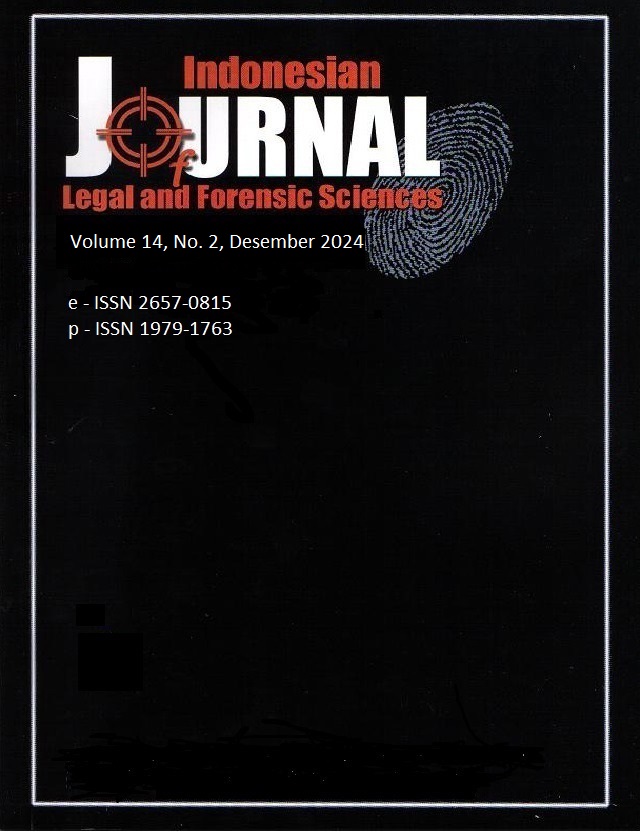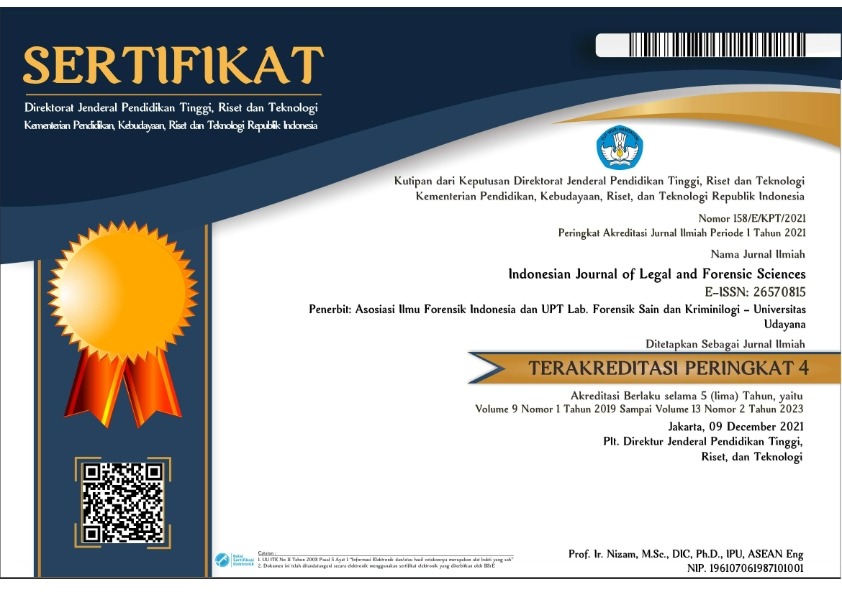Fakta Forensik yang Mengungkapkan Pembunuhan dalam Kasus Dugaan Kecelakaan: Laporan Kasus yang Menguak Kebenaran di Balik Pengakuan
Abstract
Blunt force trauma is an action that causes injury to body tissues due to an impact with a blunt object. The most commonly affected areas are the head and neck, which can lead to death. Blunt force trauma resulting in death can be intentional or accidental, such as in cases of homicide.
A 19-year-old male body was found lying face-up, covered by bushes. External examination revealed abrasions on the chest, left abdomen, and right cheek. Internal examination showed skull fractures starting from the front right side and extending in a linear pattern through the eye socket, left and right sides, and the back of the skull. There was a tear in the dura mater on the left side, causing brain extrusion and bleeding.
Blunt trauma refers to injuries caused by impacts, falls, or physical assaults with blunt objects, influenced by acceleration and deceleration forces. Although it is often associated with motor vehicle accidents, the victim, found 2 meters away from his motorcycle, should have shown signs of secondary injuries from being thrown from the vehicle. However, the absence of injuries from being dragged on the road, or contact with gravel, dirt, or sand, and the lack of damage to the motorcycle raised suspicions of a potential homicide. Based on the presence of larvae, the time of death was estimated to be 3-4 days prior to discovery, suggesting the body had been moved and staged to resemble a traffic accident. The skull fractures and intracranial bleeding indicated that the head injury from a blunt object was the cause of death.
Forensic examination plays a crucial role in identifying the cause of death. In this case, although initially suspected to be a motor vehicle accident, forensic findings revealed that the death was caused by blunt force trauma.
Downloads
References
A. B. Syatirah, J. Dase, A. Makmun, D. Mathius, and A. B. Gani, “Prevalensi Luka Memar pada Kasus Kekerasan dalam Rumah Tangga,” Indonesian Journal of Health, vol. 4, no. 1, Jun. 2024.
A. L. King, M. S. Finnin, and C. M. Kramer, “Significance of Skull Fractures and Traumatic Brain Injuries Potentially Caused by Blunt-Impact Non-Lethal Weapons,” Jul. 2018.
U. O. Eze and K. A. Ojifinni, “Trauma Forensics in Blunt and Sharp Force Injuries,” Journal of West African College of Surgeons, vol. 12, no. 4, p. 94, Nov. 2022, doi: 10.4103/jwas.jwas_190_22.
E. D. Marissha, “Insidensi Tingkat Kematian akibat Trauma Benda Tajam dan Benda Tumpul yang Diperiksa di Bagian Forensik Rumah Sakit Bhayangkara Medan VeR 2021,” Institutional Repository Universtas Islam Sumatera Utara, Dec. 2022.
G. Azizah, D. Achmad, R. P. Indarwati, D. Mathius, A. Dhedie, and P. Sam, “Gambaran Luka akibat Kekerasan Tumpul dan Tajam pada Korban Penganiayaan di RS Bhayangkara Kota Makassar Tahun 2023,” Prepotif: Jurnal Kesehatan Masyarakat, vol. 8, no. 2, Aug. 2024.
T. K. Wardani, B. A. Gizela, and B. Pratiti, “Gambaran Luka Akibat Kekerasan Tumpul dan Tajam pada Korban Penganiayaan di IGD RSUP DR. Soeradji Tirtonegoro,” 2021. [Online]. Available: http://etd.repository.ugm.ac.id/
D. Y. Priyambodo and S. P. Pidada, “Kematian akibat Kekerasan Tumpul Kepala pada Korban Anak yang Ditemukan di Dalam Sumur: Laporan Kasus,” e-CliniC, vol. 9, no. 2, 2021, doi: 10.35790/ecl.9.2.2021.34016.
Badan Pusat Statistik, “Jumlah Kasus Kejahatan Pembunuhan pada Satu Tahun Terakhir (Kasus), 2020-2022,” Badan Pusat Statistik, May 2024.
Pusat Informasi Kriminal Nasional, “Hampir Semua Polda Laporkan Penindakan Kasus Pembunuhan,” EMP Pusiknas Bareskrim Polri, May 2024.
Pusat Informasi Kriminal Nasional, “Jurnal Pusiknas Bareskrim Polri Tahun 2023 Edisi Tahun 2024,” Jurnal Pusat Informasi Kriminal Nasional, 2024.
H. P. D. Karwur, E. G. Kristanto, and D. Tomuka, “Gambaran Pola dan Derajat Luka pada Kasus Kekerasan dengan Permintaan Visum et Repertum di RSUP Prof. Dr. R. D. Kandou Tahun 2020-2021,” e-CliniC, vol. 11, no. 2, pp. 192–197, Feb. 2023, doi: 10.35790/ecl.v11i2.44758.
L. V. Simon, R. A. Lopez, and K. C. King, “Blunt Force Trauma,” StatPearls, Aug. 2023.
M. S. Syam, M. Mauluddin, D. Mathius, and S. Z. Assegaf, “Laporan Kasus: Pemeriksaan Forensik Pada Kasus Kecelakaan Lalu Lintas,” vol. 2, Oct. 2023.
A. Delamou et al., “Motorcycle Accidents and Their Outcomes amongst Victims Admitted to Health Facilities in Guinea: A Cross-Sectional Study,” Adv Prev Med, vol. 2020, pp. 1–7, Jun. 2020, doi: 10.1155/2020/1506148.
G. Ganem and R. De Cássia Pereira Fernandes, “Motorcycle accidents: Characteristics of victims admitted to public hospitals and circumstances,” Revista Brasileira de Medicina do Trabalho, vol. 18, no. 1, pp. 51–58, 2020, doi: 10.5327/Z1679443520200447.
S. Alghnam et al., “Injuries following motorcycle crashes at a level-1 trauma center in Riyadh,” Ann Saudi Med, vol. 39, no. 3, pp. 185–191, 2019, doi: 10.5144/0256-4947.2019.185.
Ç. Özdöl, T. Gediz, and K. Aghayev, “Cranial and spinal injuries in motorcycle accidents: A hospital-based study,” Ulusal Travma ve Acil Cerrahi Dergisi, vol. 25, no. 2, pp. 167–171, Mar. 2019, doi: 10.14744/tjtes.2019.46116.
National Institute of Neurological Disorders and Stroke, “Traumatic Brain Injury (TBI),” National Institute of Health, Jul. 2024.
A. M. Almulhim and R. G. Menezes, “Evaluation of Postmortem Changes,” StatPearls, May 2023.
I. Joseph, D. Mathew, P. Sathyan, and G. Vargheese, “The use of insects in forensic investigations: An overview on the scope of forensic entomology,” J Forensic Dent Sci, vol. 3, no. 2, p. 89, 2011, doi: 10.4103/0975-1475.92154.
P. Saukko and B. Knight, Knight’s Forensic Pathology, 4th ed. CRC Press, 2015. doi: 10.1201/b13266.
K. N. Reddy and O. Murty, The Essentials of Forensic Medicine & Toxicology, 35th ed. JAYPEE BROTHERS MEDICAL PUBLISHERS, 2022.
[24] E. Giovannini et al., “Motorcycle injuries: a systematic review for forensic evaluation,” Int J Legal Med, vol. 138, no. 5, pp. 1907–1924, Sep. 2024, doi: 10.1007/s00414-024-03250-y.
M. I. Isa, T. W. Fenton, A. C. Goots, E. O. Watson, P. E. Vaughan, and F. Wei, “Experimental investigation of cranial fracture initiation in blunt human head impacts,” Forensic Sci Int, vol. 300, pp. 51–62, Jul. 2019, doi: 10.1016/j.forsciint.2019.04.003.
H. Whitwell, C. Milroy, and D. du Plessis, Forensic Neuropathology. CRC Press, 2021. doi: 10.1201/9781003158035.



















